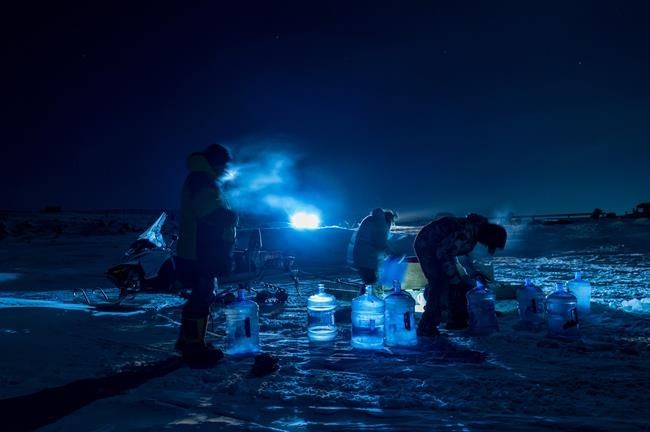IQALUIT, Nunavut — Emails between the City of Iqaluit and Nunavut Health Department staff show there was a debate over how to respond to the capital's water emergency last year.
Some 8,000 Iqaluit residents couldn't drink tap water for nearly two months after it was found to be contaminated with fuel.
Trace amounts of fuel were also found in January when residents again reported smelling it in the water.
The city and Health Department faced hurdles in co-ordinating a response as questions arose about what was and wasn't safe with the water, indicate the emails obtained by The Canadian Press under Nunavut's access-to-information legislation.
The emails show there was an emergency meeting early in the afternoon of Oct. 12before a do-not-consume order was issued around 6 p.m.
The city published a list of frequently asked questions about the water the next day.
"We took a lot of heat today for not getting the FAQs out earlier and we are hoping that scheduled messages will be helpful," Amy Elgersma, the city's chief administrative officer, wrote to health staff on the night of Oct. 13.
Some Iqaluit residents have water pipeddirectly to them, while others have city trucks deliver water which is stored in tanks inside their homes.
A topic of debate in the FAQs was whether residents who depended on trucked water needed to clean their tanks before the city filled them with river water.
The city said no. The health department suggested there wasn't enough evidence to draw that conclusion.
"Again our concern is that draining tanks may not remove all contamination, and our recommendation will continue to be that water from tanks should not be consumed," Dr. Michael Patterson, the territory's chief public health officer, wrote on Oct. 13.
"This was not what was agree(d) on in yesterday's meeting. Switching messaging will further confuse residents and erode trust. We are not planning on changing this," Elgersma wrote that same day.
In a statement to The Canadian Press, the Health Department said advice about the tanks was based on what was known about the contaminants at the time.
"The Department of Health advised the City of Iqaluit that there were concerns about the tank water because, at the time, there was insufficient data regarding the product that had contaminated the water supply," the department said in the statement.
The emails also show a spill was reported in Lake Geraldine, the city's water source, on Oct. 18, when a Department of Fisheries and Oceans employee noticed a sheen on the surface.
In a statement, the city said inspectors "didn't find anything of concern" and weren't able to determine "if it was in fact a spill or if it was a natural sheen that can occur from organics breaking down."
The city said it had installed a water quality monitoring station that can detect hydrocarbons in the water.
"To date, there has been no detection of hydrocarbons in the raw water coming from Lake Geraldine," it said. "The water from Lake Geraldine, the source of the drinking water, is very high quality."
A spill report from Crown Indigenous Relations and Northern Affairs Canada said the source and cause were unknown and the product was "petroleum — unknown."
Water test results from October, which were included in the emails, were heavily redacted. The Health Department said in response to the information request that it "received them in confidence and (they) would remain confidential."
"Disclosing these records could reasonably (be) expected to impair relations with the city," the department said.
An analysis of the results shows the fuel that contaminated Iqaluit's water for almost two months last year could be jet fuel.
Patterson said it's difficult to be sure it's a match.
'It's impossible to identify every single compound in it, or it's very hard to," he said. Most fuels are "soups or mixtures of a bunch of different hydrocarbon molecules."
The city’s treatment plant has been off-line since the January discovery of fuel in the water. A bypass has been installed that pumps in lake water, which is treated before being delivered to residents.
This report by The Canadian Press was first published March 7, 2022.
___
This story was produced with the financial assistance of the Facebook and Canadian Press News Fellowship
Emma Tranter, The Canadian Press



